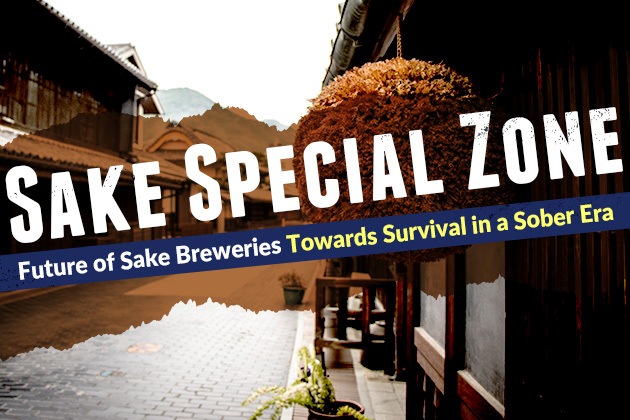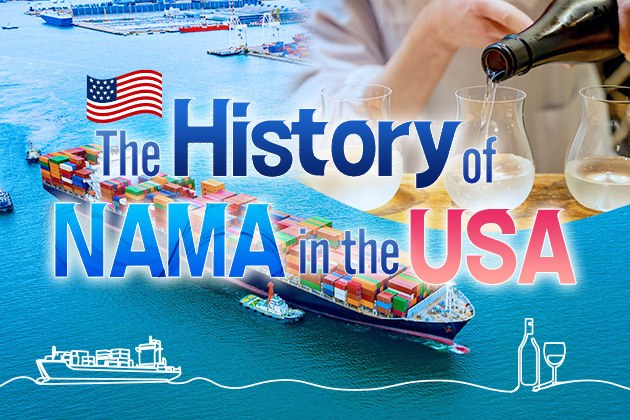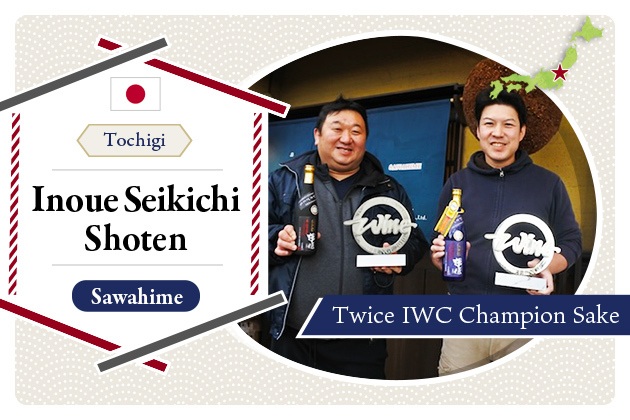
2025.08
20
Can a 'Sake Special Zone' Become Reality? — Rethinking the Future of Sake Breweries Towards Survival in a Sober Era
For over half a century, Japan’s licensing system has effectively restricted the issuance of new permits for sake production. Unlike wine or beer, where launching a new brand or opening a facility is a matter of paperwork and capital, the barriers to entry for sake brewing remain prohibitively high. Recently, however, several regions have begun to explore a workaround: the tokku system—special regulatory zones that allow certain legal exceptions for limited areas or sectors. These initiatives have sparked fresh debates, particularly among existing breweries.
In our previous two articles, we examined:
- The historical background behind the regulatory framework and past efforts to dismantle it;
- Recent movements toward tokku applications, highlighting the cases of Fukukou Sake Brewery and Iné to Agave, two producers attempting to navigate this new landscape;
- A wide range of perspectives voiced by established brewers, gathered through a nationwide survey.
In this piece, we take a closer look at how past tokku cases—whether they gained national traction or became widely accepted in their own communities—have been realized. From there, we consider what these examples might suggest for the future of sake regulation and how diverse motivations and visions can (or should) be incorporated into the evolving system.
Learning from Successful Tokku Cases: What It Takes to Turn Policy into Practice and Public Acceptance
Is a Clear Social Benefit the Key to Nationwide Adoption?
Japan’s tokku (special regulatory zones) system was first introduced in 2002 under Prime Minister Junichiro Koizumi as a tool to promote structural reform and regional revitalization. In 2013, the Abe administration expanded the initiative with the launch of National Strategic Special Zones, aimed at boosting industrial competitiveness. Together, these programs have yielded more than 140 regulatory exceptions—many of which have gone on to become permanent national policies.
A closer look at successful cases reveals a key pattern: in order for a tokku to lead to nationwide regulatory reform, it must present a clear and compelling solution to a visible social issue.
Case 1: Addressing the Shortage of Tour Guides with "Regional Interpreter Licenses"
One of the most persuasive arguments for regulatory reform is the resolution of a supply shortage. In the mid-2010s, as Japan saw a sharp rise in inbound tourism, concerns emerged over the lack of qualified interpreters. In response, a series of tokku were introduced in cities like Kyoto to loosen licensing requirements for regional tour guides.
Following successful trials, the government officially recognized the Regional Interpreter Guide system in 2018 as part of national legislation. A similar example—though not yet expanded nationally—is the “Regional Childcare Worker” certification, which was introduced in 2015 and had enabled approximately 8,600 people to become qualified by the end of FY2023.
Case 2: Car Sharing as a Response to Environmental and Cultural Shifts
Even in cases where reforms might pose a disadvantage to existing industries, if the broader societal benefit is evident, tokku-based models can still achieve nationwide adoption. Car sharing is one such case. Now commonplace across Japan, it was initially launched in Hiroshima and other areas under the tokku system.
Several studies—including one commissioned by the Tokyo Metropolitan Government in 2021—predict that the spread of car sharing could lead to a decline in vehicle sales (though other studies suggest differing outcomes). Yet the auto industry was simultaneously under pressure to address broader challenges, such as reducing environmental impact and responding to the shift toward a sharing economy.
Recognizing these larger societal needs, the government supported experimental implementation through tokku, ultimately expanding the policy nationwide in 2006.
Regional Branding and Risk Management: Lessons from Other Tokku Initiatives
Case 3: The “Doburoku Tokku” and the Branding of Rural Japan
Not all tokku lead to nationwide reform—some find their greatest success in revitalizing local communities and establishing strong regional identities. One such example is the Doburoku Tokku, a type of special zone closely related to sake production, and arguably one of the most successful in terms of local branding.
In Tono City, Iwate Prefecture, the introduction of the tokku was part of a broader effort to address depopulation in rural areas and to build a tourism model rooted in the region’s strengths—its agrarian culture and rich natural environment. According to Mr. Kurauchi from the city’s industrial planning division, the tokku was introduced as part of a green tourism strategy aimed at revitalizing the countryside.
Following its implementation, the city was able to allow farmers and inns to serve homemade doburoku, and it launched promotional events such as the “Dobekko Festival.” Kurauchi notes that this combination of doburoku and green tourism contributed significantly to community revitalization. In fact, within five years of the tokku’s launch, annual tourist numbers had risen by approximately 100,000—a 10% increase.
Today, over 200 Doburoku Tokku zones have been established across Japan, but Tono has distinguished itself through proactive promotion, to the point that it’s now widely associated with the doburoku movement. The region is even seeing new businesses emerge, such as “non° (nondo),” which produces and sells doburoku online. Kurauchi attributes this success to doburoku’s cultural familiarity in the region, which helped ensure local buy-in and foster a self-sustaining ecosystem of production and tourism.
Case 4: Corporate Land Ownership and the Limits of Regulatory Reform
While some tokku aim to stimulate innovation and community vitality, others attempt to address more sensitive issues, such as structural reforms in agriculture. One such initiative, introduced in 2016 under the National Strategic Special Zones framework, allowed certified corporations to acquire farmland—a controversial shift in Japan’s tightly controlled land policies.
The rationale was to attract private-sector investment to help counteract the growing labor shortage and boost agricultural productivity. However, public concern remained high, with fears that companies might purchase farmland for speculative purposes, convert it to non-agricultural use, or abandon it if profits failed to materialize.
To address these risks, the system included strict pre-approval processes, legal obligations for continued farming, and a clause allowing local governments to reclaim the land if it wasn’t used appropriately. While these safeguards helped assuage fears of farmland loss, they also made the system complex and difficult for businesses to navigate.
As a result, uptake has been limited. Many companies continue to prefer lease-based arrangements, which are already well-supported under existing laws. Consequently, corporate ownership of farmland remains a niche option rather than a widespread solution.
What Should the “Sake Special Zone” Aim to Achieve?
Public Affairs: A Strategic Tool for Sake Industry Reform
Whether within the framework of tokku or broader regulatory liberalization, realizing institutional reform in the sake industry requires more than just ambition. Policymakers must be presented with a clear rationale—demonstrating the social value of reform while offering concrete responses to potential risks and concerns.
In recent years, one concept gaining traction in this context is Public Affairs (PA).
Unlike traditional lobbying, which often evokes images of behind-the-scenes negotiations with a limited number of politicians or bureaucrats, PA represents a broader, more transparent form of engagement. It refers to the open and strategic efforts by businesses and organizations to align their missions with the public interest—and to help shape the legal and regulatory landscape that supports that alignment. This is typically done through dialogue with a diverse range of stakeholders, including media, scholars, civil society, and administrative bodies.
As the relationship between alcohol and society continues to shift
Makaira Inc., a consultancy specializing in PA in Japan, emphasizes the importance of defining two foundational questions before initiating advocacy:
- Why should this policy be implemented?
- What specifically needs to change, and how?
To apply this lens to the ongoing debate over sake production licensing, we must first understand the broader societal context—particularly the evolving global stance toward alcohol.
In 2010, the World Health Organization adopted a Global Strategy to Reduce the Harmful Use of Alcohol. As part of its 2030 Action Plan, it set ambitious goals, including a 20% reduction in harmful alcohol consumption and the implementation of effective policy interventions in 70% of participating countries.
Governments worldwide have since responded. Lithuania implemented a blanket ban on alcohol advertising. In Scotland, a minimum unit pricing system for alcohol was introduced in 2018 and increased by 30% in 2024. In the United States, discussions are underway to mandate cancer warning labels on alcohol packaging.
Japan, too, is seeing policy shifts. The government has launched a Basic Plan for the Promotion of Measures against Alcohol-related Health Disorders, and is currently considering mandatory labeling of pure alcohol content on packaging. In 2024, newly proposed national drinking guidelines drew public attention, and industry groups have begun voluntarily discussing tighter advertising and e-commerce regulations.
Beyond regulation, Japan’s alcohol industry faces a more fundamental challenge: structural demographic change.
Two major trends—the aging of the population and evolving lifestyle habits—are expected to cause a long-term decline in alcohol consumption. According to projections from Kita Sangyo, a company that produces and distributes alcohol packaging, the number of daily drinkers in Japan is expected to decline by half by 2060.
This is driven not only by a declining overall population, but also by the increasing proportion of older drinkers and a sharp drop in alcohol consumption among younger generations. While behavioral trends may be influenced by awareness campaigns or new product categories, demographic shifts are largely irreversible—and must be treated as a given when considering the future of the industry.
Navigating Social Change: A Sustainable Transition for the Sake Industry
As we have seen, the relationship between alcohol and society is shifting dramatically—and major beer and spirits producers in Japan are already responding. The "Big Four" breweries have begun to diversify into health-related businesses, reform their core structures, expand product portfolios to meet diverse consumer preferences, and actively promote responsible drinking.
In contrast, over 99% of Japan’s sake producers are small or medium-sized enterprises. For these businesses, addressing such societal changes is not just a challenge but a critical opportunity. Ensuring the long-term sustainability of the sake industry in the face of evolving attitudes toward alcohol may well constitute a compelling “Why” for regulatory reform.
In addition, the sake sector is increasingly concerned about the future of local economies and agriculture—two pillars it has long supported—as well as the shortage of next-generation producers.
From this perspective, several key “What” questions arise:
What kind of business environment should we aim to create?
- Diversification of products and distribution channels to reflect evolving consumer tastes
- Support systems for small-scale producers, including easing administrative burdens
- Sustainable development of local industries and agriculture, with stable regional employment
- Mitigation of abrupt industry disruption caused by external environmental or policy shifts
What kinds of institutional support would enable this?
- Relaxation of excessive restrictions on e-commerce and market entry for new producers
- Simplified tax administration and reduced reporting frequency for small-scale sake makers
- Cross-sector policies that integrate alcohol regulation with regional development, tourism, and agriculture
- Frameworks for collaboration between established and emerging producers, along with phased reforms and support for SMEs
In PA, once the “Why” and “What” are defined, the next step is strategic communication—the “How.” Through consistent outreach and public engagement, stakeholders work toward building broad-based understanding and social consensus.
Examples of PA outreach activities include:
- Sharing information through media (articles, press releases, social media)
- Hosting or participating in symposiums, seminars, and public events
- Preparing policy briefs and holding briefings for ministries and lawmakers
- Maintaining open dialogue with industry peers and trade associations
- Engaging directly with consumers and sake enthusiasts
What’s critical in this process is not merely pushing demands but adopting an inclusive, dialogic approach—one that listens to diverse voices, acknowledges legitimate concerns, and co-develops a sustainable path forward. Ultimately, it is through this shared process that the sake industry can adapt to change while preserving its cultural and economic relevance for generations to come.
Roles and Responsibilities Across Sectors
As discussed in our previous article, debates surrounding Sake Tokku and regulatory reform often involve conflicting interests between two camps: those advocating for new market entry and those—typically established producers—favoring the status quo or taking a more cautious stance.
To move beyond these divisions and foster constructive dialogue, what roles and responsibilities should each side take on?
For Those Advocating Deregulation
Proponents of reform must broaden the scope of the conversation, aiming not for isolated one-on-one negotiations between individual applicants and local brewers, but rather for sector-wide dialogue—many-to-many—that encourages inclusive, collective engagement.
The current pattern, in which deregulation is pursued on a case-by-case basis, risks becoming a "divide-and-conquer" dynamic that may inflame tensions among stakeholders instead of fostering long-term consensus. To avoid this, it is crucial that reform-minded actors build coalitions—groups of businesses and individuals who share similar goals and can present a more representative voice when engaging with existing industry players and government bodies. A unified front is also more likely to attract public support and build bridges with adjacent sectors such as tourism, agriculture, or food service.
At the same time, efforts already underway—such as negotiations within specific regions or active tokku applications—remain essential drivers of change. The challenge lies in aligning these local movements with a broader, coordinated strategy that fosters shared understanding across the entire industry.
For Those Opposed to Reform
Conversely, those who wish to maintain the current regulatory framework must also articulate their positions more openly. This means clearly and convincingly presenting their vision for the future of the industry, and explaining why regulatory continuity is vital.
As advocates for reform increasingly turn to public discourse, it is no longer sufficient to oppose change from behind closed doors. In today’s information-rich, highly networked society, silence can quickly breed speculation—or worse, conspiracy theories. A lack of transparency can become a liability.
To ensure their concerns are heard and respected, conservative voices must participate in the public debate with clarity and sincerity. Articulating concerns, offering counterproposals, and engaging in transparent dialogue is not only a defensive measure—it is a step toward building mutual trust and shaping a future in which the industry evolves on shared terms.
Summary
The debate over sake brewing licenses and the broader movement toward deregulation—particularly through the introduction of Sake Tokku zones—is not merely a niche policy issue. It touches on much deeper questions: the future of Japanese culture, regional economies, and traditional industries as a whole.
In addition to changing societal norms and the direction the government has signaled over the years, what stands out today is the passion of those who are actively working to bring about change. Their energy is contagious—like the spark of an Olympic flame—gradually igniting awareness and engagement across the industry and beyond. Given this momentum, it is unlikely that the conversation will simply fade away.
The key question is how we choose to respond to this shift—and how we shape the future it points toward. Rather than framing the situation as a conflict between “those destroying tradition” and “those resisting progress,” can we instead return to a shared purpose? That is, ensuring that sake—both as an industry and a cultural heritage—is passed on, strengthened, and reimagined for future generations.
To do so, we must invest in dialogue. Each side brings with it a unique vantage point, set of challenges, and aspirations. Through sustained, transparent conversation, we can deepen mutual understanding and find common ground. By applying the principles of Public Affairs—framing the issues clearly, aligning reforms with public benefit, and openly addressing concerns—we can move toward regulatory change that is not only strategic, but also socially legitimate and lasting.
The social shifts outlined in this article are likely to present real and serious challenges for the sake industry. Overcoming them will require open-minded discussion and collective problem-solving—including, where necessary, institutional reform. It is our hope that more people from across the spectrum will take part in these conversations, not only to defend their interests, but to contribute to a future in which sake continues to thrive.
Can a 'Sake Special Zone' Become Reality?
Can a 'Sake Special Zone' Become Reality? — Tracing the Origins and Future of Japan’s Strict Licensing Barriers
References
- Kyoto City Government. Structural Reform Special Zone Plan (Kyoto Interpreter Guide Tokku). Accessed May 2, 2025.
- Japan Tourism Agency. Overview of the Revised Interpreter Guide Law. Accessed May 2, 2025.
- Chugoku Transport Bureau. Eco-Friendly Car Sharing. Accessed May 2, 2025.
- Mitsubishi Research Institute. Tax Revenue Simulation for Automobile-Related Tax Systems (commissioned by Tokyo Metropolitan Government, 2021).
- Sumitomo Mitsui Banking Corporation. Trends in Car Sharing, 2017.
- Cabinet Office, Regional Revitalization Portal. Hiroshima Car Sharing Tokku Case Study. Accessed May 2, 2025.
- Nikkei Shimbun. “Corporate Land Acquisition Now Possible Nationwide—Pending Final Government Approval,” March 3, 2023.
- Cabinet Office. Fourth Meeting of the Action Plan Execution Working Group – Materials on Corporate Farmland Ownership. 2003.
- Shibuya Yukio. “Examining Concerns About Corporate Entry into Agriculture: Survey of Prefectural Officials.” Tokyo University of Agriculture Bulletin, Vol. 63, No. 3-4, 2019.
- Onaka Katsutoshi. “Research Trends and Future Issues in Corporate Farming.” Journal of Agricultural Problems, Vol. 52, No. 1, 2020.
- World Health Organization. Global Alcohol Action Plan 2022–2030. Accessed May 2, 2025.
- AFP BB News. “Lithuania Enforces Total Alcohol Advertising Ban.” January 11, 2018.
- Scottish Wholesale Association. Minimum Unit Pricing Posters & Retail Guidance. Accessed May 2, 2025.
- BBC News Japan. “Record High Alcohol-Related Deaths in England.” December 19, 2024.
- Nikkei Shimbun. “U.S. Considers Cancer Warning Labels for Alcohol.” January 4, 2025.
- Kita Sangyo Co., Ltd. Sake STATICS: Declining Population and Aging Society. Accessed May 2, 2025.
- Ministry of Health, Labour and Welfare. Basic Plan for Alcohol Health Disorder Measures (Phase II), 2021.
- Asahi Group Holdings. Integrated Report 2024. Accessed May 2, 2025.
- Asahi Group Holdings. Factbook 2024. Accessed May 2, 2025.
- Asahi Group Holdings. Japan Business Strategy. Accessed May 2, 2025.
- Asahi Beer. Smart Drinking (SumaDori). Accessed May 2, 2025.
- Kirin Holdings. 2022–2024 Mid-Term Business Plan: New Growth Track. Accessed May 2, 2025.
- Kirin Holdings. Financial Results for Fiscal Year Ending December 2024 [IFRS, Consolidated]. Accessed May 2, 2025.
- Kirin Holdings. What is Slow Drinking? Accessed May 2, 2025.
- Suntory Holdings. Financial Results for FY2024 [IFRS, Consolidated]. Accessed May 2, 2025.
- Suntory Holdings. FY2024 Earnings Presentation Materials. Accessed May 2, 2025.
- Suntory Holdings. Wellness Business Overview. Accessed May 2, 2025.
- Suntory Holdings. Drink Smile Initiative. Accessed May 2, 2025.
- Sapporo Holdings. Global Expansion Strategy. Accessed May 2, 2025.
- Sapporo Holdings. Group Mid-to-Long Term Growth Strategy. Accessed May 2, 2025.
- Sapporo Holdings. FY2024 Financial Overview and FY2025 Management Plan. Accessed May 2, 2025.
Pickup Articles
2019.01.18
2019.01.25
Trending Articles
Popular Articles
Recent Articles













